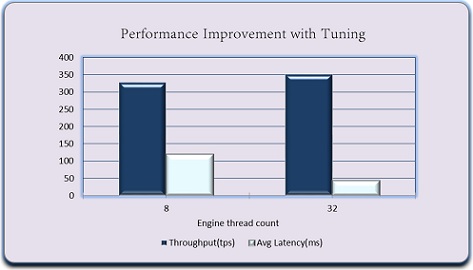Throughput Improvement for SOAP and REST Services
Use Case 1 : The focus of the project was related to scalability and maximizing throughput for a given workload for SOAP and REST services deployed on a single AppNode.
For scenario details, see Performance Improvement Use Case 1 .
The was achieved by tuning certain TIBCO ActiveMatrix BusinessWorks™ parameters. These tests were conducted on Amazon EC2 servers with the following configuration:
8 vCPUs - Intel Xeon E5-2680 v2 @ 2.80 GHz (25 MB Cache)
- Tuned the ActiveMatrix BusinessWorks™ engine thread count. Initially tested with default eight engine threads and then doubled the threads depending on the CPU utilization.
- Tuned the HTTP Client max total connections and max connections/host depending on the calls to the external services deployed and the engine thread value.
- Tuned the HTTP Client thread pool depending on the calls to external services deployed and the HTTP Client max total connections value.
Results
An increase in throughput (tps) and reduction in latency was achieved by following a step by step tuning approach as illustrated in the graphs below. The first graph illustrates the performance achieved by tuning the engine threads alone.
The second graph shows further improvement in performance after tuning the HTTP Client connections and threads.


